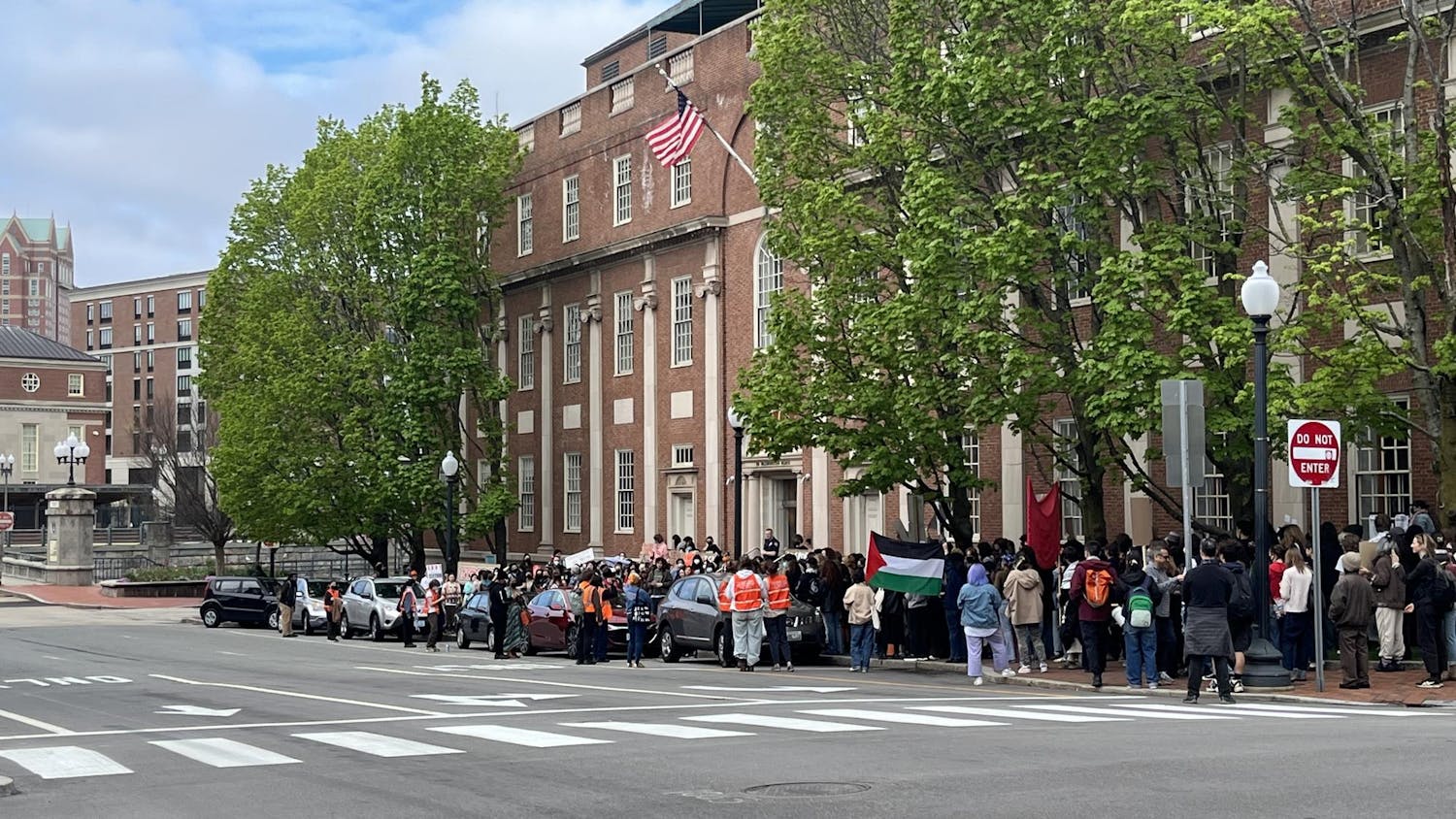Wilma Smith was only 17 years old when she first became homeless. She was no longer eligible for the Massachusetts foster care system and did not have an apartment or a place to go.
"Even though I'd received a scholarship to Duke University, I had a child and so going to school wasn't an option," she said.
Instead, Smith lived in shelters, with friends and on the streets for four years, until she received public housing assistance from the Boston Housing Authority.
Even then, her housing was not secure. Seven years after she moved in, her building was sold. The new owners turned her out of the apartment, and Smith moved to a women's interim shelter in Pawtucket.
"The roughest part about being homeless was giving up early on my dreams," she said. "The roughest part about being a homeless mother was knowing what needed to be done to take care of my children but not having the services or the ability to get to that point."
Due to the recession, Smith's experience has become more common, with more Rhode Islanders homeless this year than last.
A steady increase
Experts say the number of homeless children and families has increased over the past five years. But precise figures are difficult to obtain because of variations on how "homeless" is defined and changes in reporting methods.
Last week, Rhode Island Kids Count released its annual factbook detailing the economic, psychological and educational status of the state's youth. That data reveals high numbers of homeless children and families, many of whom are without a home for the first time due to the economic downturn.
"In 2010, we sheltered 109 women and children. In 2009, we sheltered just under 80," said Jennifer Barrera, program manager at Lucy's Hearth, a transitional shelter for homeless women and their children in Middletown.
But the number of people in shelters alone does not give a full picture of the level of homelessness.
Rhode Island public school personnel, who are required by law to identify homeless children and provide them with transportation and other assistance, estimate that 44 percent of homeless children are in shelters while 42 percent stay with relatives or friends, 10 percent stay in hotels and 4 percent remain unsheltered.
Changes in the needs of the state's homeless are placing new strains on shelters.
"Families have to stay longer in shelters because there's less affordable housing on the other end," said Stephanie Geller, a policy analyst for Rhode Island Kids Count. "This makes it difficult for shelters to provide adequate services."
Barrera said more mothers rely on the agency's program for all of their daily needs. In the past, "moms pretty quickly learned to budget money and pay off their bills. Now moms aren't able to achieve some of the program goals," she said.
These state trends reflect national statistics. A March 6 "60 Minutes" report found that 16 million Americans were homeless in 2010, up from 14 million in 2008. That report also noted the increasingly long-term nature of homelessness.
But experts believe homelessness in Rhode Island may not be as bad as in other states.
"There are some reports from a couple years ago suggesting that Rhode Island was above average," Geller said. Since then, the state's homeless problem has likely gotten worse, she added.
Connected causes
Unemployment, lack of affordable housing and reduced government assistance — brought on by the economic downturn — are making it more difficult than ever for homeless families.
State unemployment rates have been declining for 11 months, according to the Department of Labor and Training, but Rhode Island still struggles with double-digit unemployment. In February, the state's unemployment rate was 11.2 percent, the highest in New England.
"The high unemployment situation in Rhode Island definitely has contributed to the increase of homeless families and children," said Jim Ryczek, executive director of the Rhode Island Coalition for the Homeless. He added that the availability of affordable housing in the state is below average.
The average cost of rent in Rhode Island increased by 56 percent between 2000 and 2010 — from $748 to $1,165 — far outpacing national growth. Rhode Island has the highest percentage of households spending more than 30 percent of their income on rent, according to Kids Count's factbook.
Rhode Island has the highest foreclosure rate in New England. Between January 2009 and December 2010, there were 4,738 foreclosures in the state, which amounts to a loss of $5.6 billion in wealth, according to a March 1 Providence Journal article.
In 2008, Rhode Island shelters saw a 300 percent increase in homelessness due to foreclosures. Over one-third of Rhode Island foreclosures are of multi-family rental units, which, when closed, can cause two to three families to lose their homes, according to Ryczek.
"Rhode Island had a non-tenant friendly policy, where the landlord didn't have to notify tenants by law that the property was being closed on," Ryczek said. "You heard stories of landlords collecting rents up until foreclosures."
But in 2009, the federal government passed the Protecting Tenants at Foreclosure Act, which specified landlords must give tenants at least 90 days notice of foreclosure.
Decreasing government aid
The Neighborhood Opportunities Program, a state-funded program for affordable housing established in 2001, orginally subsidized both development and operation of affordable housing. But since 2008, due to budget cuts, the program only subsidizes rents for families with very low incomes, neglecting the development of new affordable housing.
Also, the program is a fund-as-you-go initiative that requires representatives to vote every year on its existence. Rhode Island is one of nine states without a dedicated fund for affordable housing, according to the Kids Count factbook.
In July 2008, the state changed the name of the Family Independence Program — which offered up to five years of monetary, housing, transportation and educational assistance to pregnant women and adults with children — to the Rhode Island Works Program. The change came with eligibility restrictions and a two-year time limit for cash aid.
In August 2010, shelters saw a dramatic spike in the number of families seeking assistance after their final Family Independence Program aid packages expired, according to Ryczek. He said shelters generally see an increase after the holiday season, when families lose their housing or feel they can no longer rely on friends' charity.
"Simply put, Rhode Island Works doesn't work," Barrera said. "The program now has requirements that some parts of the homeless population just can't meet."
Some of the women in Lucy's Hearth can only read at a fourth-grade level, according to Barrera. "As a result of the state's high unemployment, they're forced to compete for RI Works approval and for jobs filling your coffee at Dunkin' Donuts with people who have master's degrees."
Barrera also noted that homeless families have practical concerns that make it more difficult for them to qualify for government aid than low-income families on the brink of losing their housing.
"To apply for housing, you need all sorts of documents," said Smith, the formerly homeless mother. "When you're homeless, you tend to lose those sort of things moving from one place to another carrying your life on your back. It creates this sort of vicious cycle, where to escape homelessness, you really need a reliable place to store your possessions."
The budget strikes a blow
Gov. Lincoln Chafee '75 P'14 unveiled his proposed $7.66 billion budget March 8, which would address the state's $331 million shortfall by cutting funding to some departments and increasing taxes.
Chafee proposed reducing the sales tax from
7 percent to 6 percent and imposing new taxes on currently exempt items like over-the-counter drugs, haircuts and car repairs. He also proposed a 1 percent sales tax on other previously tax-exempt items including clothing, heating fuel and water for residential use.
Chafee emphasized that instead of cutting services, his budget focuses on restructuring departments to make them more efficient. But, he said in an address to state legislators, "at the end of the day, I urge you to recognize that we simply cannot continue to fund our current level of services."
Advocates for the homeless are troubled by many aspects of Chafee's budget.
The budget would trim $60 million from the state Department of Health and Human Services, which is on track to grow by $96 million between 2008 and 2012. The Department of Children, Youth and Families, a sub-department of Health and Human Services, would have its budget cut by $13.6 million under Chafee's proposal.
More recently, Chafee proposed cutting the Neighborhood Opportunities Program from the budget. Rhode Island Housing, a quasi-public agency that relies on federal funding, should pay for the $1.5-million program instead, he said at a March 20 press conference.
Experts agree that cuts to programs and agencies that address homelessness would be more of a blow to the homeless community than sales tax changes.
"Mental health services, substance abuse services, family counseling, life skills courses, parenting classes. … Not having these services available is an open invitation to repeat the cycle of homelessness. You can't just give people housing, although that's unarguably the most important step," Smith said.
But Chafee has taken a positive step by reviving the Interagency Council on Homelessness, according to Ryczek. The Council is charged with figuring out how state agencies can work together most effectively to tackle homelessness.
Common ground
Smith is now pursuing a master's degree in case management at Rhode Island College. She has four children, the oldest of whom is a student at Job Corps. It has been 14 years since she was last homeless, but she said the experience still feels recent.
Smith rejects the perception that it was an entirely negative stage in her life.
"Sure, there are people in the homeless community who can tear you down with things like substance abuse," she said. "But there are also people who are really supportive. … I couldn't have escaped homelessness without my friends."
Homelessness should not be treated as "an unfortunate stigma," Barrera said. "It's the people pouring your coffee at Dunkin' Donuts. It's the receptionist at your doctor's office. It's the kid on your school bus."




